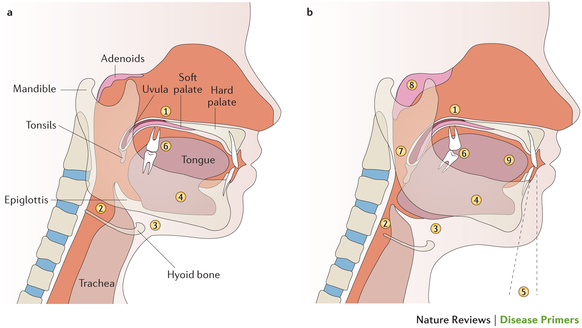Review Abstract
閉塞性睡眠時無呼吸症候群
Obstructive sleep apnoea syndrome
2015年6月25日 Nature Reviews Disease Primers Article number: 15015 (2015) doi: 10.1038/nrdp.2015.15

閉塞性睡眠時無呼吸症候群(OSAS)は、よく見られる臨床症状であり、睡眠中に咽喉の狭小化または虚脱が繰り返されるため、閉塞性睡眠時無呼吸イベントの原因になる。この症候群は特に中年期以降によくみられる。上気道の虚脱が起こる機序について、完全には明らかにされていないが、肥満、頭蓋顔面の異常、上気道筋の機能的異常、咽頭の神経障害、および頸部への体液移動などの多くの原因が考えられている。虚脱によって直接的に、間欠的低酸素状態・高二酸化炭素状態、周期性覚醒および呼吸努力の増加が起こり、二次的な交感神経活性の亢進、酸化ストレスおよび全身性炎症が誘発される。日中の過剰な眠気は大多数の患者の負担となっている。OSASは、代謝機能不全をはじめ、高血圧、不整脈、脳卒中、冠動脈疾患、アテローム性動脈硬化などの心血管系共存症、および心血管疾患死亡率の全般的な上昇とも関連している。睡眠時無呼吸による慢性的影響が、睡眠時無呼吸を治療することで改善し得るかについては、適正によくデザインされた試験によって明らかにする必要がある。持続陽圧呼吸(CPAP)療法は、重症OSAS患者の治療の第一選択であるが、軽症から中等症の治療としては口腔内装置も広く普及している。最後に、CPAPのような種々の治療法と体重管理の併用には効果があるが、今後、無作為対照試験において評価する必要がある。
Obstructive sleep apnoea syndrome (OSAS) is a common clinical condition in which the throat narrows or collapses repeatedly during sleep, causing obstructive sleep apnoea events. The syndrome is particularly prevalent in middle-aged and older adults. The mechanism by which the upper airway collapses is not fully understood but is multifactorial and includes obesity, craniofacial changes, alteration in upper airway muscle function, pharyngeal neuropathy and fluid shift towards the neck. The direct consequences of the collapse are intermittent hypoxia and hypercapnia, recurrent arousals and increase in respiratory efforts, leading to secondary sympathetic activation, oxidative stress and systemic inflammation. Excessive daytime sleepiness is a burden for the majority of patients. OSAS is also associated with cardiovascular co-morbidities, including hypertension, arrhythmias, stroke, coronary heart disease, atherosclerosis and overall increased cardiovascular mortality, as well as metabolic dysfunction. Whether treating sleep apnoea can fully reverse its chronic consequences remains to be established in adequately designed studies. Continuous positive airway pressure (CPAP) is the primary treatment modality in patients with severe OSAS, whereas oral appliances are also widely used in mild to moderate forms. Finally, combining different treatment modalities such as CPAP and weight control is beneficial, but need to be evaluated in randomized controlled trials. For an illustrated summary of this Primer, visit: http://nature.asia/1HA0d3z

